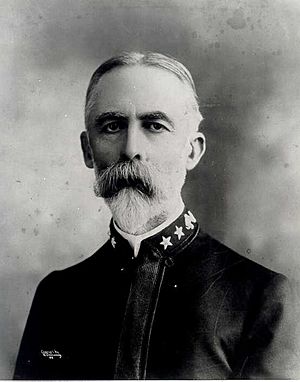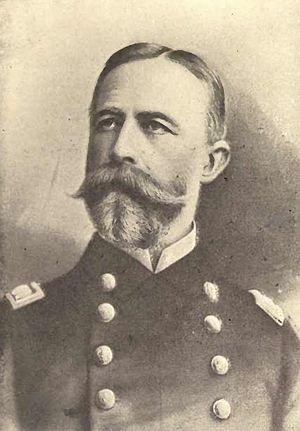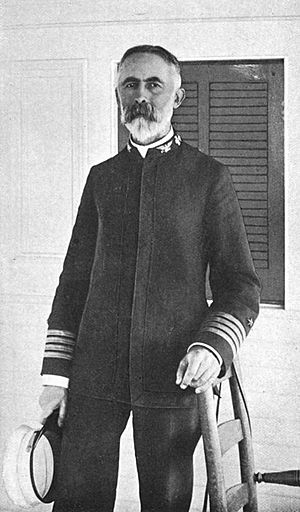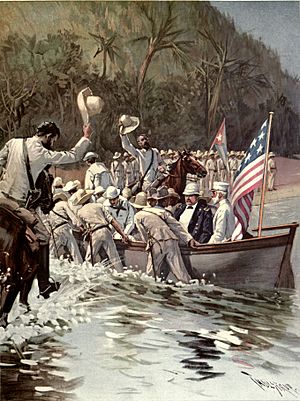William T. Sampson facts for kids
Quick facts for kids
William Thomas Sampson
|
|
|---|---|

William Thomas Sampson
|
|
| Born | February 9, 1840 Palmyra, New York, U.S. |
| Died | May 6, 1902 (aged 62) Washington, D.C., U.S. |
| Buried |
Arlington National Cemetery, Virginia, U.S.
|
| Allegiance | |
| Service/ |
|
| Years of service | 1857–1902 |
| Rank | |
| Commands held | Alert Mayflower Swatara San Francisco Iowa North Atlantic Station |
| Battles/wars | American Civil War
|
William Thomas Sampson (February 9, 1840 – May 6, 1902) was a United States Navy rear admiral. He is famous for his important victory in the Battle of Santiago de Cuba during the Spanish–American War.
Contents
William Sampson was born in Palmyra, New York. He joined the United States Naval Academy in 1857. He was a brilliant student and graduated first in his class four years later. After graduating, he taught physics at the Naval Academy.
In 1864, Sampson served on the ship Patapsco. This ship was part of the Union blockade during the American Civil War. They were clearing underwater mines near Charleston, South Carolina. On January 15, 1865, his ship hit a mine, exploded, and sank. Seventy-five lives were lost, but Sampson survived.
After the war, he continued to serve in the Navy. He taught at the Naval Academy again. He also worked in the Navy Department. He commanded several ships, including the Alert and the training ship Mayflower.
Sampson later became the Superintendent of the Naval Academy in 1886. This was a very important leadership role. He was promoted to captain in 1889. He then commanded the protected cruiser San Francisco. In 1893, he became the Chief of the Bureau of Ordnance. This meant he was in charge of weapons for the Navy.
In 1897, he took command of the battleship Iowa. A year later, he was chosen to lead an investigation. This board looked into why the Maine battleship was destroyed. Soon after, he became the commander of the North Atlantic Squadron. He was given the temporary rank of rear admiral.
The Spanish–American War
The United States declared war on Spain in April 1898. Admiral Pascual Cervera's Spanish fleet sailed from the Cape Verde Islands. Rear Admiral Sampson, on his flagship New York, sailed from Key West.
Sampson was in charge of blockading Cuba. This meant stopping ships from entering or leaving Cuban ports. He also led the attack on the city of San Juan in Puerto Rico. On May 12, 1898, his ships bombarded San Juan. This caused some damage to the city. Later, Sampson helped lead a land and sea attack on San Juan with General William Shafter. They successfully took the city. After this, Sampson returned to Cuba. He helped strengthen the blockades around Santiago and Cienfuegos.
On May 29, Sampson's forces found Admiral Cervera's fleet. The Spanish ships had entered Santiago harbor. The U.S. Navy quickly increased its presence to trap them. On July 3, 1898, Cervera's fleet tried to escape the harbor. Admiral Sampson was ashore at the time, meeting with General Shafter. They were planning a joint attack on Santiago.
Rear Admiral Winfield Scott Schley was in command of the Flying Squadron in Sampson's absence. Schley's fleet met the Spanish ships. In a five-hour sea battle, the U.S. Navy completely destroyed every Spanish vessel. The next day, Admiral Sampson sent a famous message. He announced: "The Fleet under my command offers the nation as a Fourth of July present, the whole of Cervera's Fleet."
The Controversy After Santiago
Sampson's message did not mention Schley's leadership in the battle. This led to a big argument about who deserved credit for the victory. Sampson had set up the strategy and positioned his forces well. However, Schley was the one who actually commanded the fleet during the battle.
The disagreement became very serious within the Navy. Sailors often took sides, calling themselves "Schley men" or "Sampson men." Schley asked for an official investigation, which happened in 1901. The investigation heard many people speak in support of Schley. Even with some criticism of Schley, the court cleared his name.
After the Battle of Santiago Bay, Sampson continued his service. He became the Cuban Commissioner for a short time. Then he returned to command the North Atlantic Fleet. He later became the Commandant of the Boston Navy Yard. He retired from the Navy on February 9, 1902.
Sampson received an honorary doctorate from Yale University in 1901.
Awards and Honors
- Civil War Campaign Medal
- Sampson Medal
- Spanish Campaign Medal
Namesakes
Many things have been named in honor of William T. Sampson:
- Four destroyer ships of the U.S. Navy were named USS Sampson.
- Sampson Hall at the United States Naval Academy is named after him. It houses the English and History departments.
- The Sampson Medal was created to honor those who served under his command in the Spanish–American War. Sampson was one of only four Americans to have an official medal with their own image on it.
- The former Sampson Naval Training Base in New York was named for him. It later became the Sampson Air Force Base. Today, it is a state park called Sampson State Park.
- An elementary school in Brooklyn, New York, PS 160, was named in his honor.
- The steamship SS Admiral Sampson was named after him. It was built in 1898.
- The W.T. Sampson Elementary/High School at Naval Station Guantanamo Bay is named for him.
- The town of Sampson is also named in his honor.
Personal Life
William Sampson married Margaret Sexton Aldrich in 1863. Margaret passed away in 1878. In 1882, Sampson married Elizabeth Susan Burling.
His daughter, Margaret Aldrich Smith, became the First Lady of Guam from 1916 to 1918. His granddaughter, Marjorie Sampson Smith, sponsored a Navy ship, USS Sampson (DD-63), in 1916.
Admiral Sampson died on May 6, 1902, in Washington, D.C.. He is buried at Arlington National Cemetery.
See also
 In Spanish: William Thomas Sampson para niños
In Spanish: William Thomas Sampson para niños
- List of Superintendents of the United States Naval Academy
- Puerto Rican Campaign




